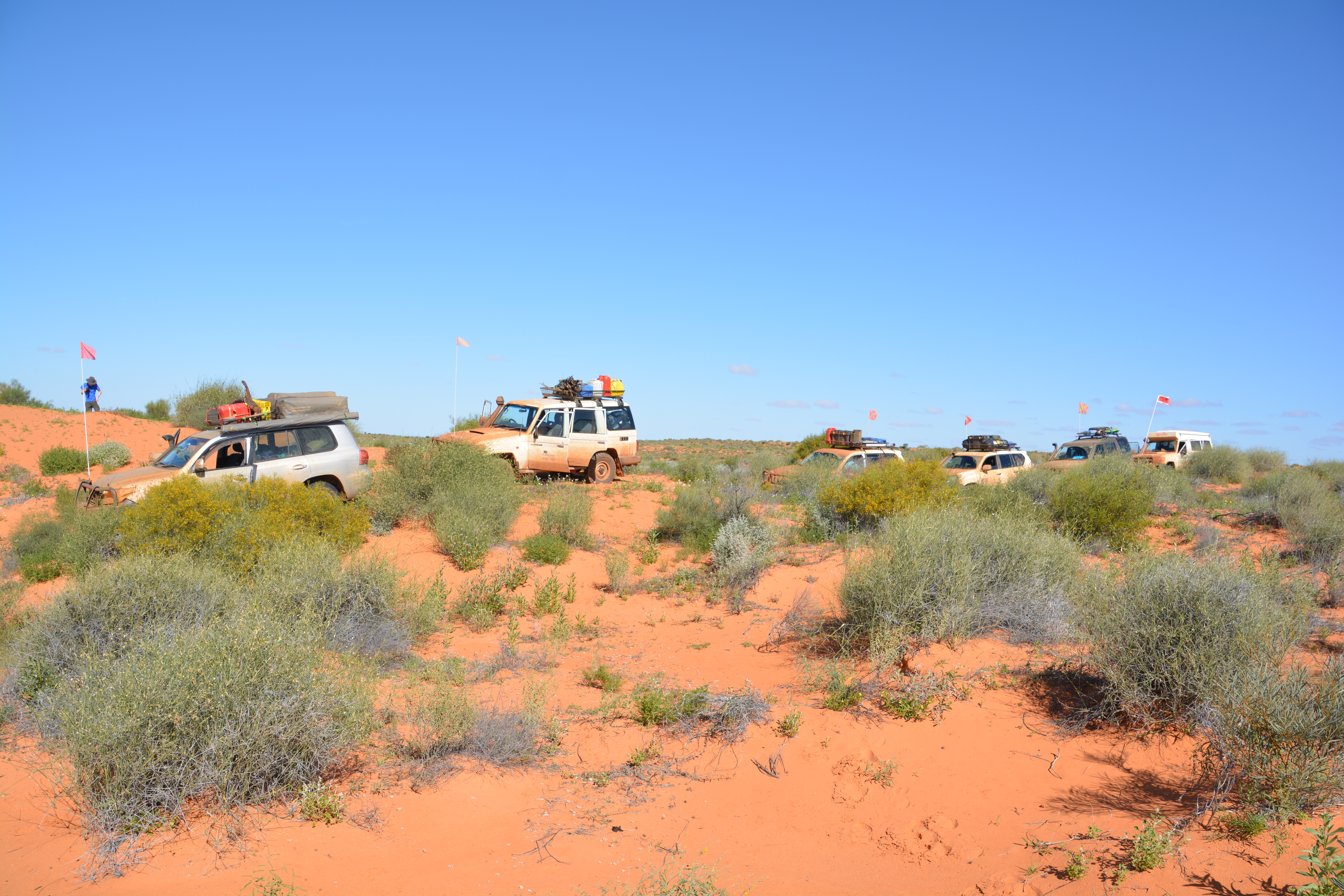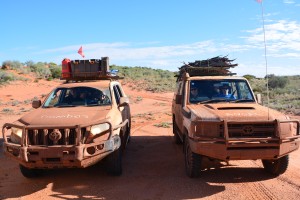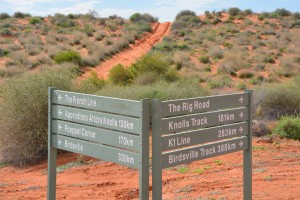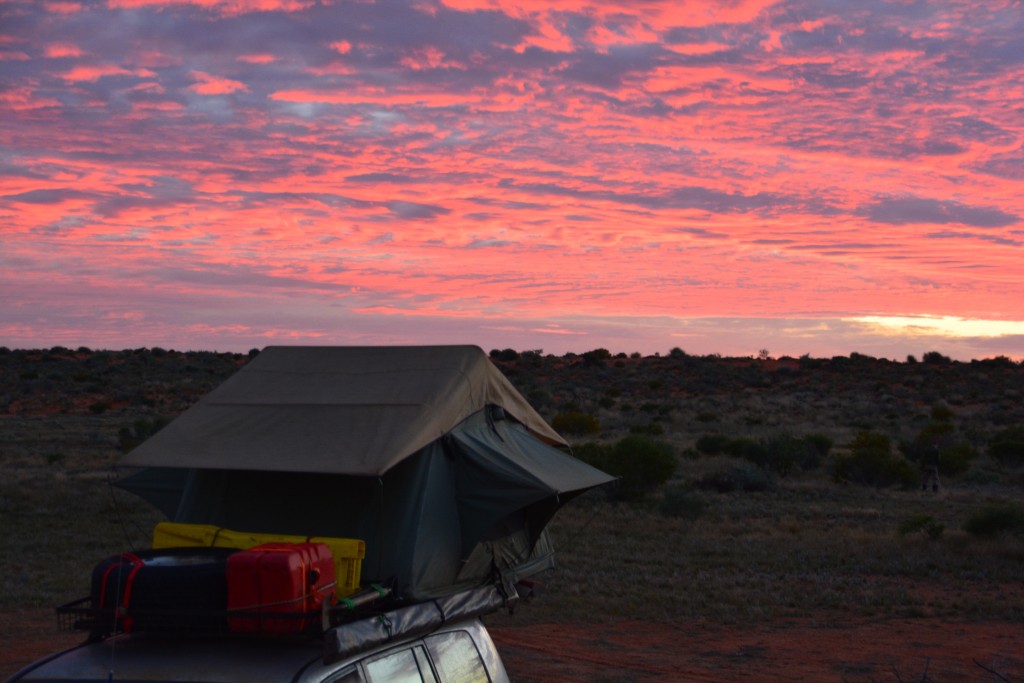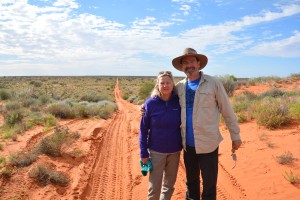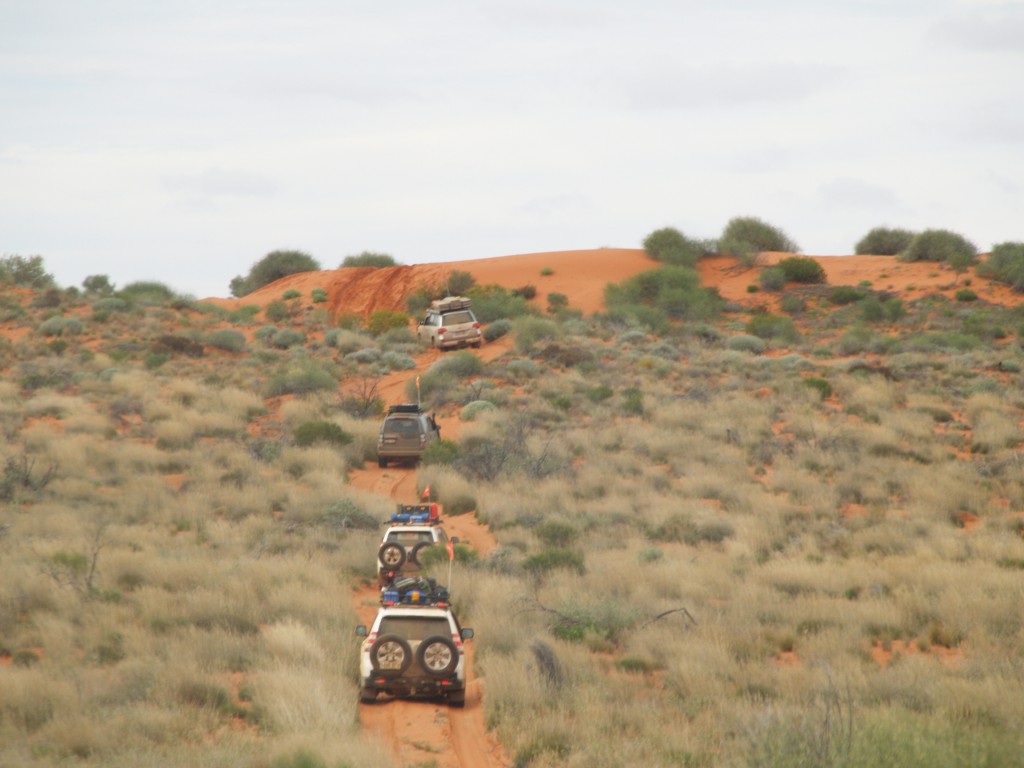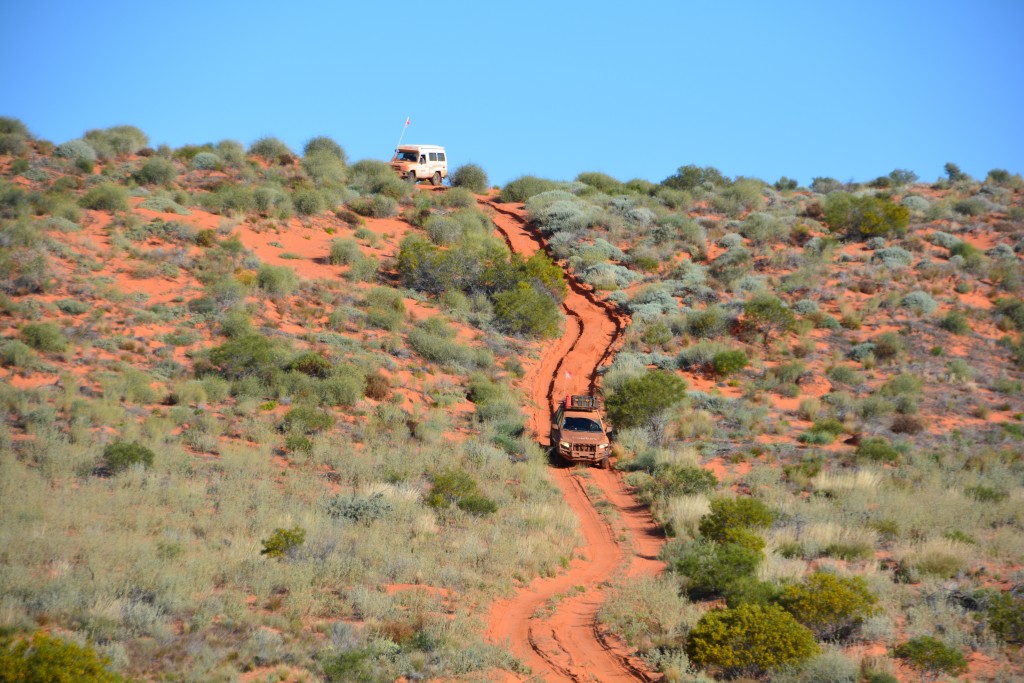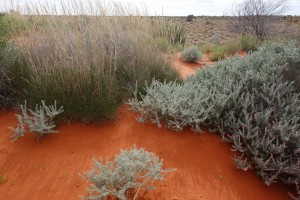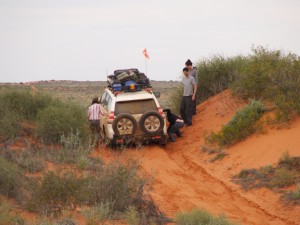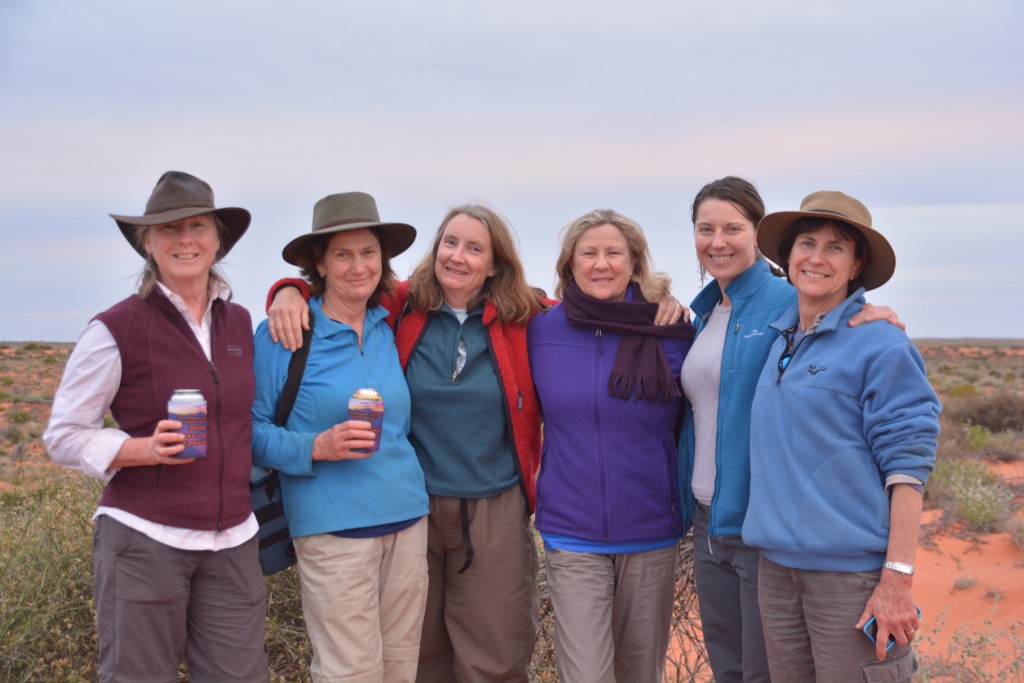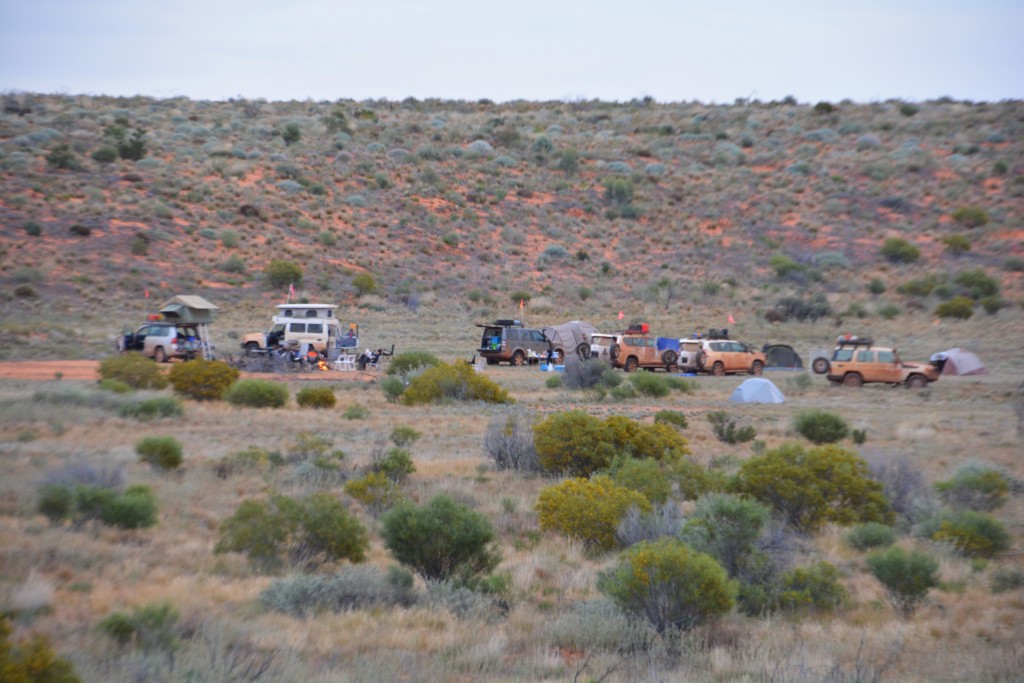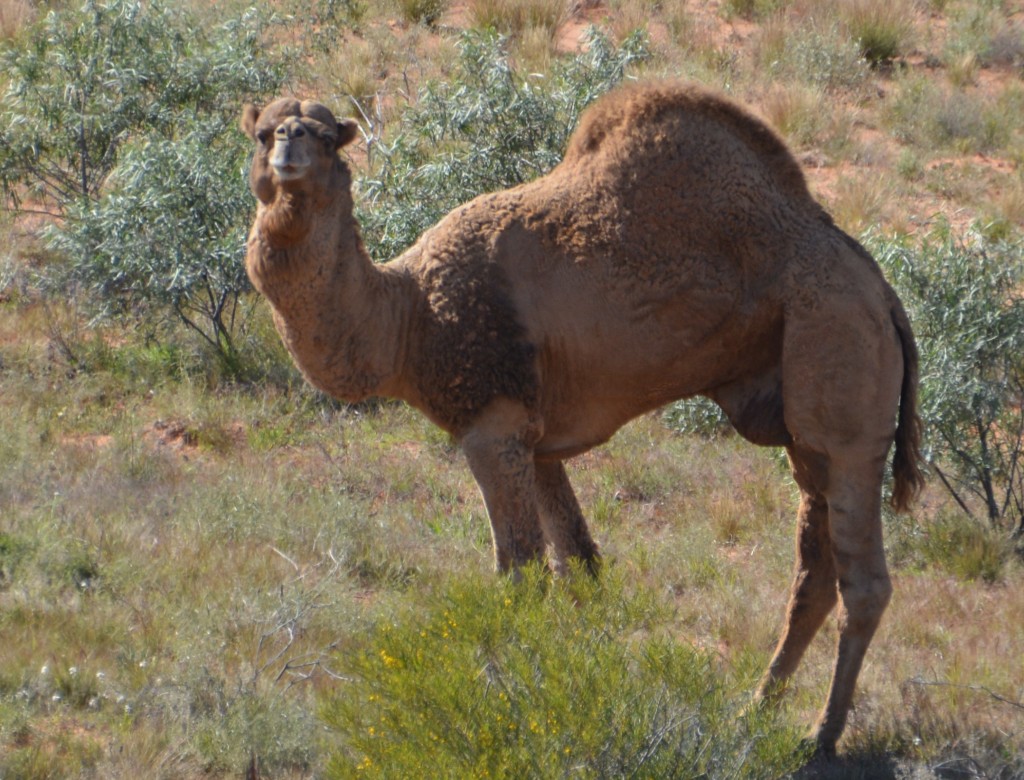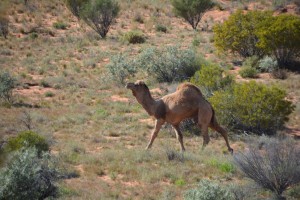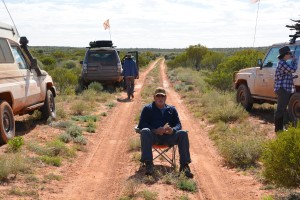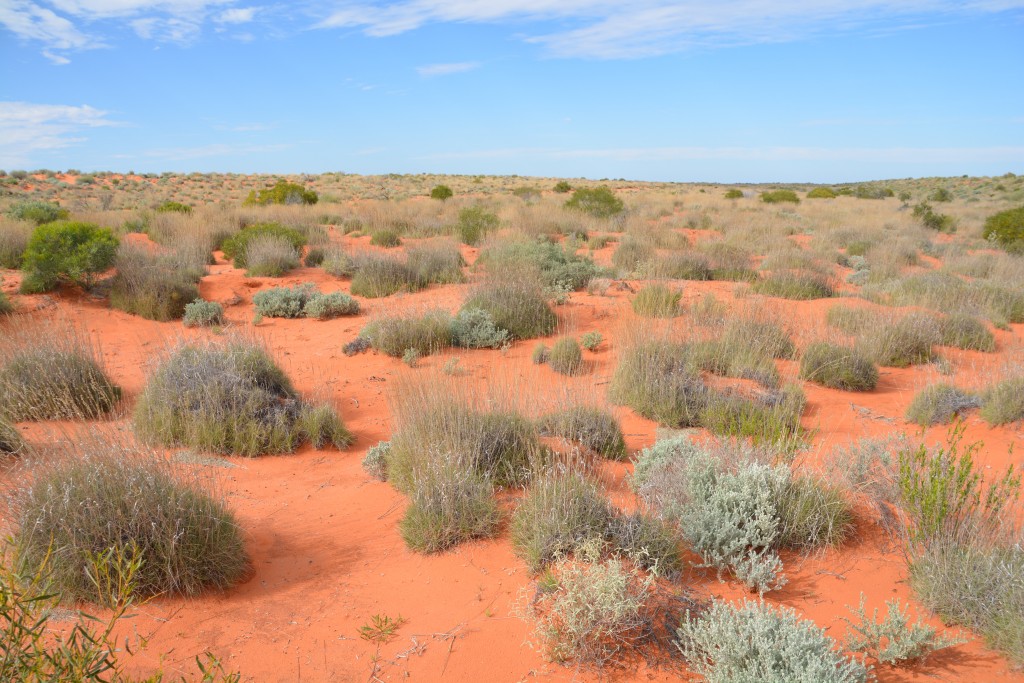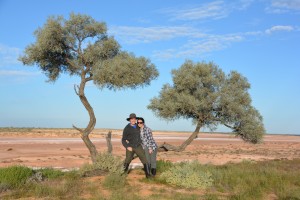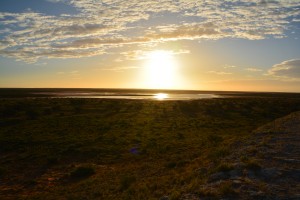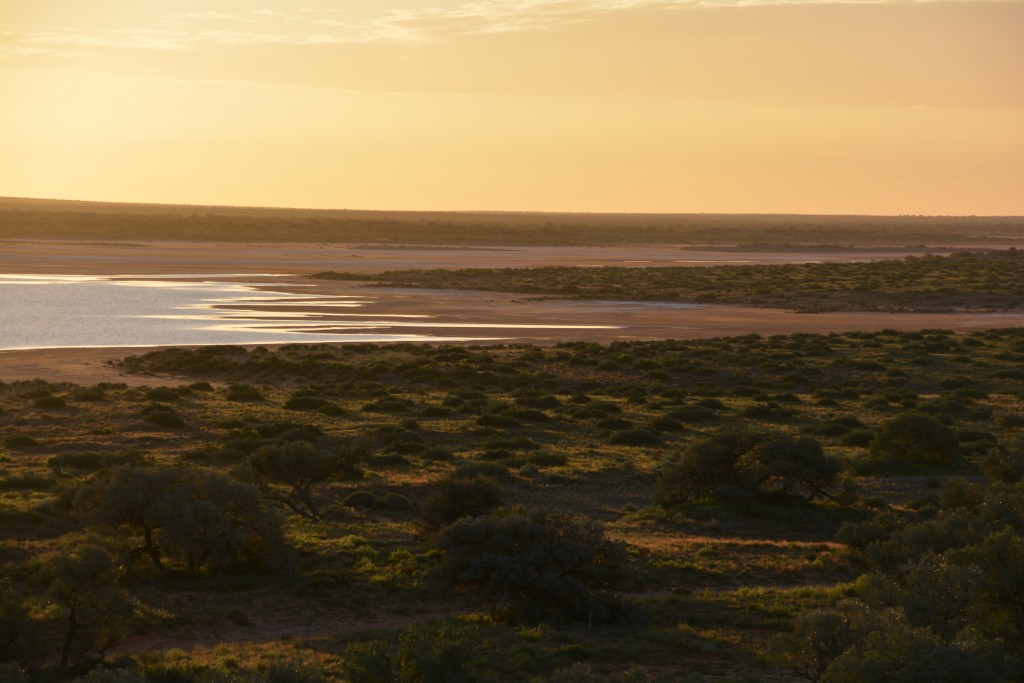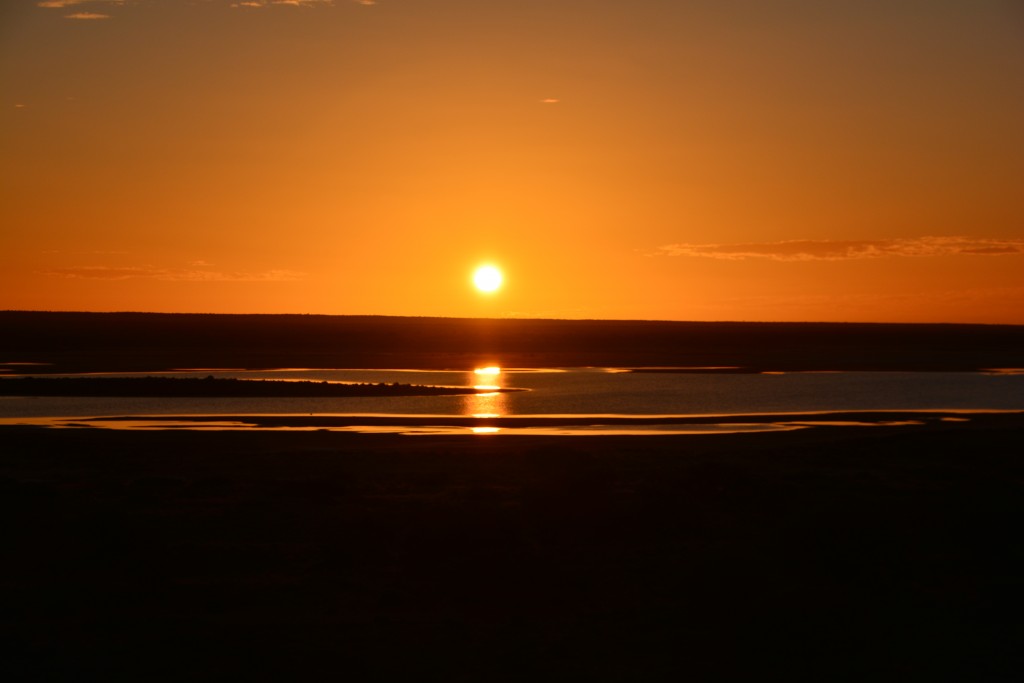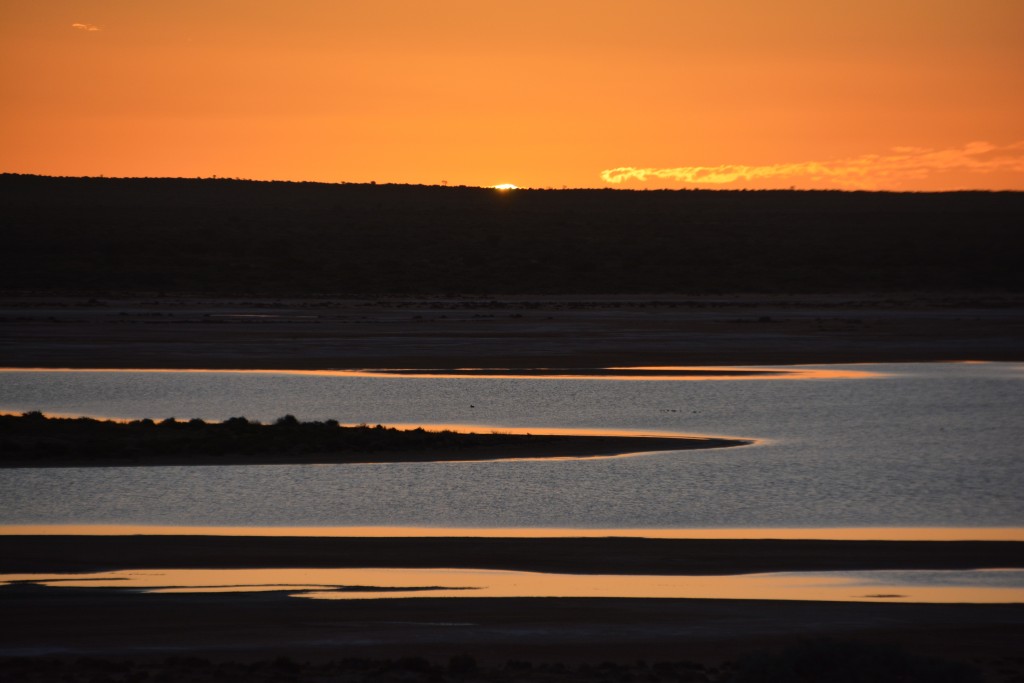We vote for more desert!
Mornings in the desert were my favourite time of day. It would always be cold, below 5 degrees, usually a thick dew across the sand, flora and tents. You could almost sense the desert waking up around you as the sun poked its head above the closest dune. The light would play off the morning clouds, creating a beautiful sunrise, and slowly our camp of 17 intrepid travellers would wake to a new day. And so it was this morning as we stoked the fire for warmth and rubbed our hands more in anticipation for the day ahead than to fight off the cold.
We continued our push eastward, following an easy undulating sand track, up and down gentle dunes covered in green bushes, flowers and scrubs. By the second hour the sand dunes started to get bigger with steeper approaches and descents and much softer sand. The drivers, which usually rotate between the passengers in each car, all had some fun little challenges as our skills were tested. Julie and I in the mighty Cruiser were the lead vehicle and we had the added risk of cresting each dune hoping no one is coming from the other direction at exactly at the same time.
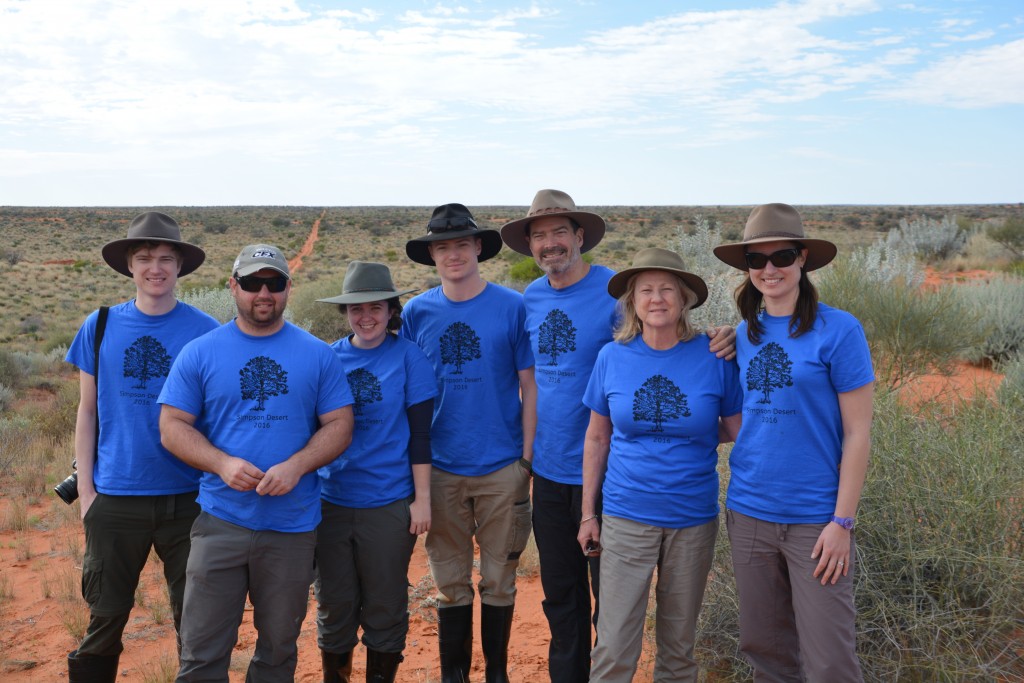
A family that dresses together drives together – Will and Gemma surprised the family with team T-shirts before the trip
While our six vehicles were communicating with each other on Channel 15, I used a hand held second radio on Channel 10, the well-publicised channel to communicate with other drivers, to make sure we knew in advance and could safely pass vehicles coming the other way. It was sometimes a bit chaotic in the cockpit as I would use Channel 10 to warn others of the Cool Convoy’s impending approach and then use Channel 15 to tell our group what we were doing, all the while driving and trying to take in the scenery.
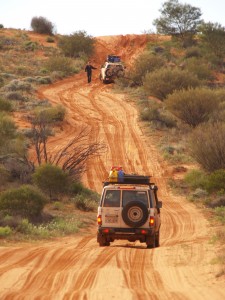
The Cool Convoy stops momentarily when one of the vehicles have to ‘reload’ over a sand dune. Photo:Kathy
This was beautiful country, probably the best we had seen so far, a colourful rolling landscape with a deep red under-base and green cover, not the remote desert we were expecting. Some dunes were a little more challenging, sometimes with little switchback twists going up the steep slopes and secondary tracks for cresting the steepest ones. Occasionally one of our vehicles would not make it to the top of a dune and would have to back down to the bottom and take another run at it. As I would constantly say, it’s all about MOMENTUM.
We started to see old and recent camel prints walking up the track between the tyre ruts and the call went out to keep an eye out for wandering dromedaries. We stopped for photos on many occasions, once for the huge paddy melons that would grow on the side of the road, other times for the dramatic sweeping landscape from the tops of sand dunes and the beautiful fields of white and yellow wildflowers.
After a few hours we found a nice place at the base of a big sand dune to stop for lunch. By now many of the dunes were 15 to 20 metres high and provided stunning views from their tops, a huge expanse of desert with a long red trail marking our track snaking off into the distance. And then it would be on to the next set of dunes, up and over many times, concentrating on the technical side of the driving but trying to take in these amazing scenes all around us.
There are many tracks across the Simpson Desert with some running east-west across the dunes and others running north-south between the dunes. Our plan was to zig-zag across the desert as much as we had time and fuel for, just to take in as many aspects and experiences as possible. And so it was that after many little challenges on this section of the French Line we finally made it to the intersection of the Colson Track and turned south to run between two large dunes. The track immediately became much less used and the bushes grew out over its edges, scratching our vehicles but generally running fairly flat and easy.
Here’s a short video from our GoPro hanging out the window to give you a typical sand dune experience.
With Julie driving the Cruiser and the road in much better condition we made the 19 km to the next major intersection in less than an hour. This new track is called the WAA Line and we turned left – east – as the afternoon sun sunk lower in the sky. Within a couple of sand dunes we found a great spot to camp and called stumps for the day – but not before Annie provided some entertainment by getting stuck on the last dune of the day.
Our slightly early finish for the day allowed plenty of time for people to relax a little, collect wood, explore the nearby dunes and enjoy this magnificent setting, taking photos, savouring the moment. With the fire blazing we enjoyed another cold but beautiful evening, surrounded by friends, family and tall sand dunes.
The next day we woke to a cold but dry morning and another beautiful sunrise. But this day was different because today was Voting Day! Yes, while Australia heads for the polls to choose a new government – or not – we idly enjoyed another breakfast in the middle of nowhere. To me this moment highlighted the simplicity of travel – we don’t have to worry about things like taking showers, going to work, doing the shopping, paying the bills or even voting. In the middle of the desert our biggest worry was…well, I couldn’t think of anything to worry about!
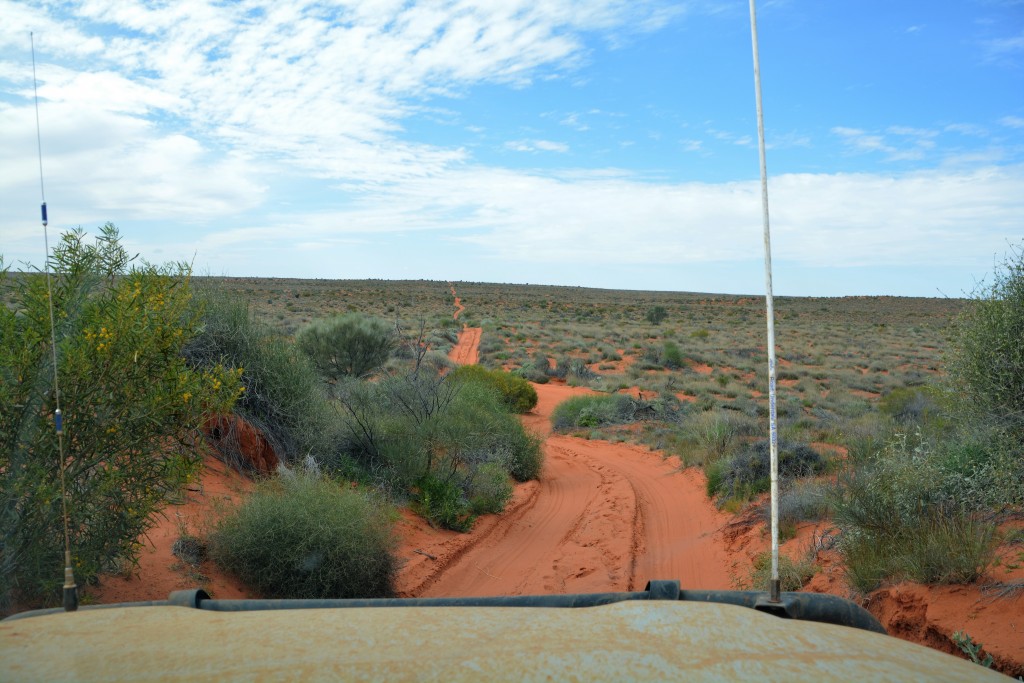
Not many polling booths out here – our remoteness made the national election seem kind of irrelevant
The WAA line features more space between the dunes but they tended to be a bit higher and we hit a few that were quite long and steep. The vehicles continued to perform magnificently without a single problem so far. And the scenery continued to be stunning, very green rolling plains of grasses and bushes, many flowers and deep red colours in the sands.
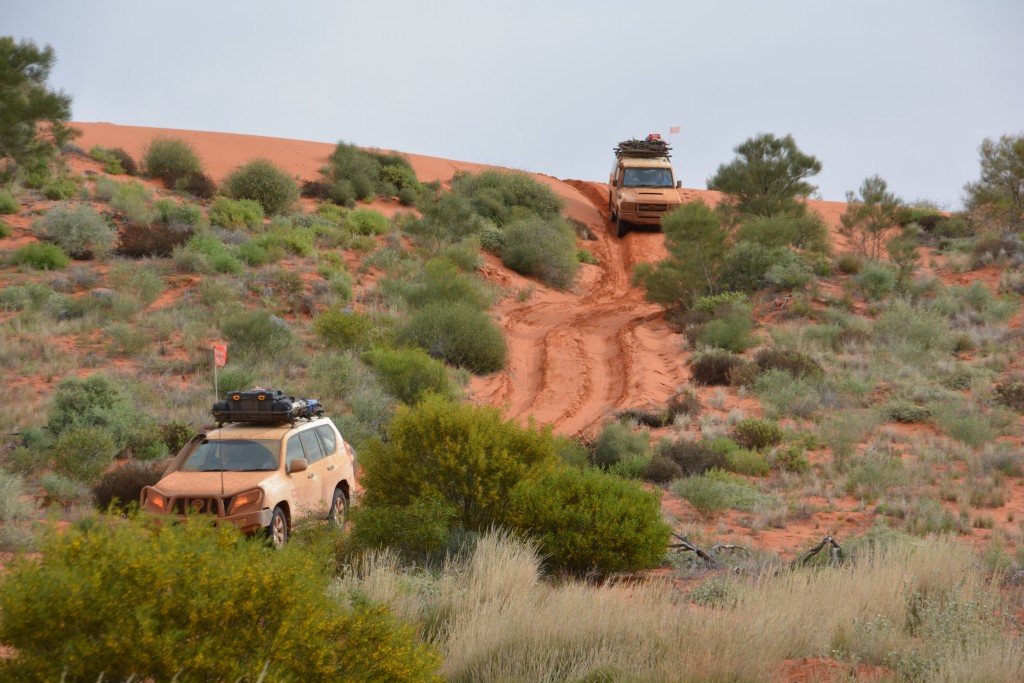
As the lead vehicle we saw most of the vehicles coming down the back side but missed most of the fun as they tried to get up the front
One particular dune saw three vehicles having to ‘reload’ at least once before making it to the crest and back down the other side but all drivers took it in good spirits and there was much cheering on Channel 15 when it was finally negotiated.
Julie and I in the lead vehicle crested another large sand dune to look down again on the vast run below us. Standing on our road immediately in front of us at the bottom of the dune was a huge healthy camel, casually gazing at us, not fazed at all, just ambling along.
We quickly all stopped and jumped out to marvel at this beast and take photos as he lazily wandered across the plains, occasionally stopping to pose for photos and gaze up at us with as much curiosity about us as we had of him. A great privilege to see him in his natural setting and a rare treat. Now we had seen both dingos and a camel, neither of which would have been certain.
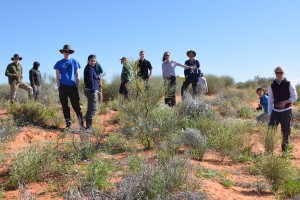
Any excuse for a stretch – driving over the bumps can be hard on the body so its good to get occasionally
This was a beautiful drive along the WAA line, stunning country under a perfect blue sky, great dunes, many of which featured tracks winding up and down each side because a trip straight up and over the dune would be too steep. These sweeping turns approaching the steep crest of the dune often provided more challenges to keep up the momentum and stay on track.
While this was all good fun and the prime focus of our entire journey, what we had come to realise by now is that our average speed across the desert was about 15km/hour. In fact, on the previous day we had travelled only 80 km the whole day. We weren’t driving slowly or taking unnecessary stops, it just takes time for six vehicles to negotiate all these dunes. And so it took almost four hours to travel the 55 km to the next intersection and turn north on the Erabena Line. This was a good flat track and after a few kilometres we stopped at a pleasant place for lunch and then continued the trip north to hook back up with the French Line.
By the time we made the French Line again, which is undoubtedly the most popular way to cross the desert, we had travelled 115 km on our little detour. During that time, which spanned the best part of two days, we did not see a single other vehicle. It was like having the entire desert all to ourselves. Amazing.
From there we turned east again on the main track, by now with dry soft sand from all the trucks that had passed through. The slightly firmer wet sand from the recent rains had been dried out by the sun and traffic. A truck coming the other way said they didn’t know who had won the election (like, who cares?) but had met 83 trucks heading towards Birdsville for the huge music festival that was being held there.
After many more dunes we came to the first of many salt flats that frequently lie between the dunes in this section of the desert. These flats fill with water in the wet winter and we were worried that some of them would still be flooded. But this first large one clearly had a dry track across its widest part and we stopped for photos of its vast expanse and its white salty rim.
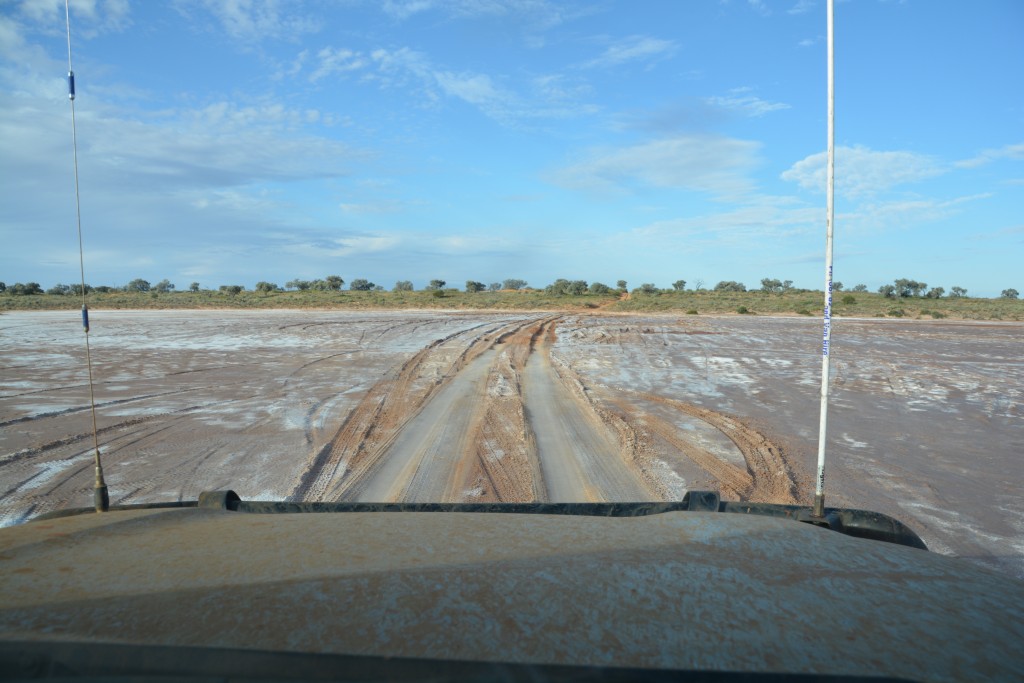
Crossing our first dry lake bed, lined with salt, marked through the mud, this one safe to drive across
Here we chose a little detour to see one of the rare geologic exceptions to the desert. We followed a flat track through an open expanse covered in old stunted gidgee trees that somehow survive in this harsh salty environment and came to a place called Approdinna Attora Knolls.
The Attora Knolls are two large white gypsum mounds – almost mini hills – that rise from the desert floor to an astonishing height of 31 metres above sea level and provide magnificent sweeping views of salt lakes nearby. The sun was getting low but we parked, took the necessary accoutrements for cocktail hour and followed the trail up to the top of these hard white salty mounds. From this scenic vantage point, sacred to Aborigines, we gained another perspective of this mighty desert and the view across the salt lake as the sun set.
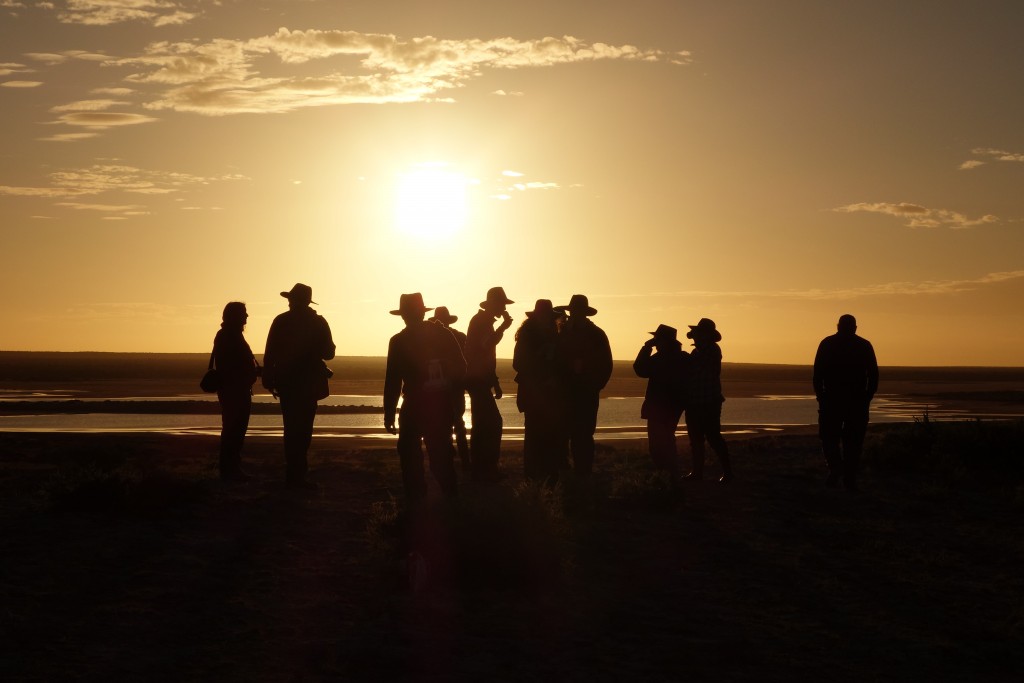
The group enjoy this special moment from the Attora Knolls with a drink in hand and stunning scenery all around
We reluctantly retreated as the light was lost and retraced a couple of kilometres for another great camping spot, this time amongst these strange gnarly old gidgee trees. Great stuff.
